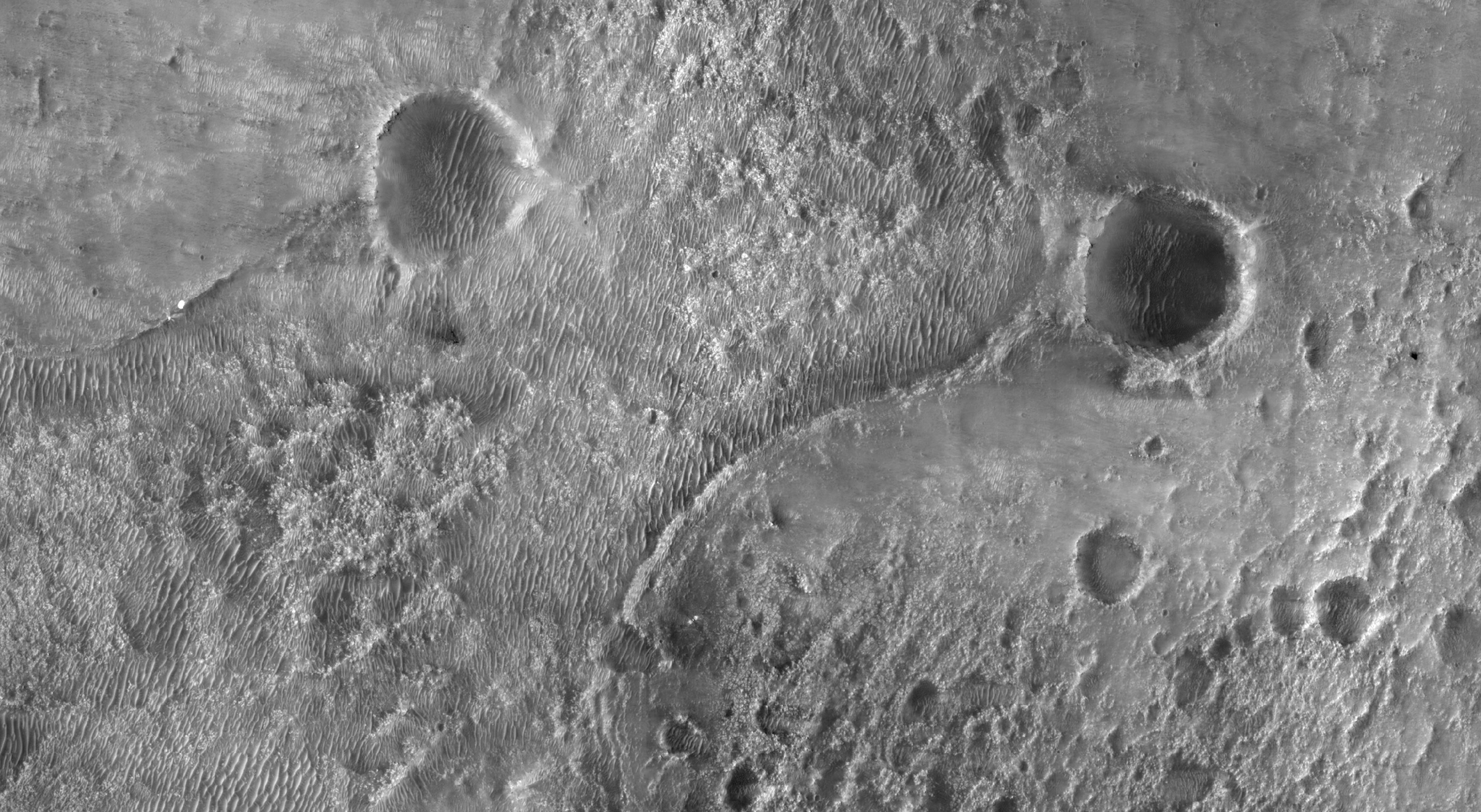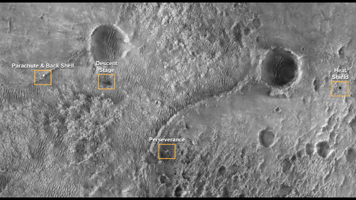
|
Perseverance and Mars 2020 Spacecraft Components on the Surface
- Click the image above for a larger view
- Full-Res JPEG (4376 x 2400) (1.3 MB)
- Full-Res TIFF (4376 x 2400) (10.3 MB)
Caption:

Figure 1
This first image of NASA's Perseverance Rover on the surface of Mars from the Context Camera (CTX) aboard NASA's Mars Reconnaissance Orbiter (MRO) shows the many parts of the Mars 2020 mission landing system that got the rover safely on the ground. The image was taken on Feb. 19, 2021.
An annotated version of the image (Figure 1) points out the locations of the parachute and back shell, the descent stage, the Perseverance rover, and the heat shield. Each inset shows an area about 650 feet (200 meters) across.
The rover itself sits at the center of a blast pattern created by the hovering descent stage that lowered it there using the sky crane maneuver. The descent stage flew off to crash at a safe distance, creating a V-shaped debris pattern that points back toward the rover. Earlier in the landing sequence, Perseverance jettisoned its heat shield and parachute, which can be seen on the surface in the separate locations illustrated.
These objects are highly visible on the surface of Mars now but will become dustier with time and slowly fade into the background over years. HiRISE will continue to image the Perseverance landing site to track the progress of the rover and changes with the other pieces of hardware that accompanied it.
Close-ups of the spacecraft can be seen in PIA24334 , PIA2335 , PIA24336 , and PIA24337 .
Background Info:
MRO's mission is managed by NASA's Jet Propulsion Laboratory, a division of Caltech in Pasadena, California, for NASA's Science Mission Directorate. Lockheed Martin Space in Denver, built the spacecraft. The University of Arizona provided and operates HiRISE.
A key objective for Perseverance's mission on Mars is astrobiology , including the search for signs of ancient microbial life. The rover will characterize the planet's geology and past climate, pave the way for human exploration of the Red Planet, and be the first mission to collect and cache Martian rock and regolith (broken rock and dust).
Subsequent NASA missions, in cooperation with ESA (European Space Agency), would send spacecraft to Mars to collect these sealed samples from the surface and return them to Earth for in-depth analysis.
The Mars 2020 Perseverance mission is part of NASA's Moon to Mars exploration approach, which includes Artemis missions to the Moon that will help prepare for human exploration of the Red Planet.
NASA's Jet Propulsion Laboratory, which is managed for NASA by Caltech in Pasadena, California, built and manages operations of the Perseverance rover.
For more about Perseverance: mars.nasa.gov/mars2020/
Cataloging Keywords:
| Name | Value | Additional Values |
|---|---|---|
| Target | Mars | |
| System | ||
| Target Type | Planet | |
| Mission | Mars Reconnaissance Orbiter (MRO) | Mars 2020 |
| Instrument Host | Mars Reconnaissance Orbiter | Perseverance |
| Host Type | Orbiter | Rover |
| Instrument | Context Camera (CTX) | |
| Detector | ||
| Extra Keywords | Dust, Grayscale, Moon | |
| Acquisition Date | ||
| Release Date | 2021-02-22 | |
| Date in Caption | 2021-02-19 | |
| Image Credit | NASA/JPL-Caltech/MSSS | |
| Source | photojournal.jpl.nasa.gov/catalog/PIA24333 | |
| Identifier | PIA24333 | |
